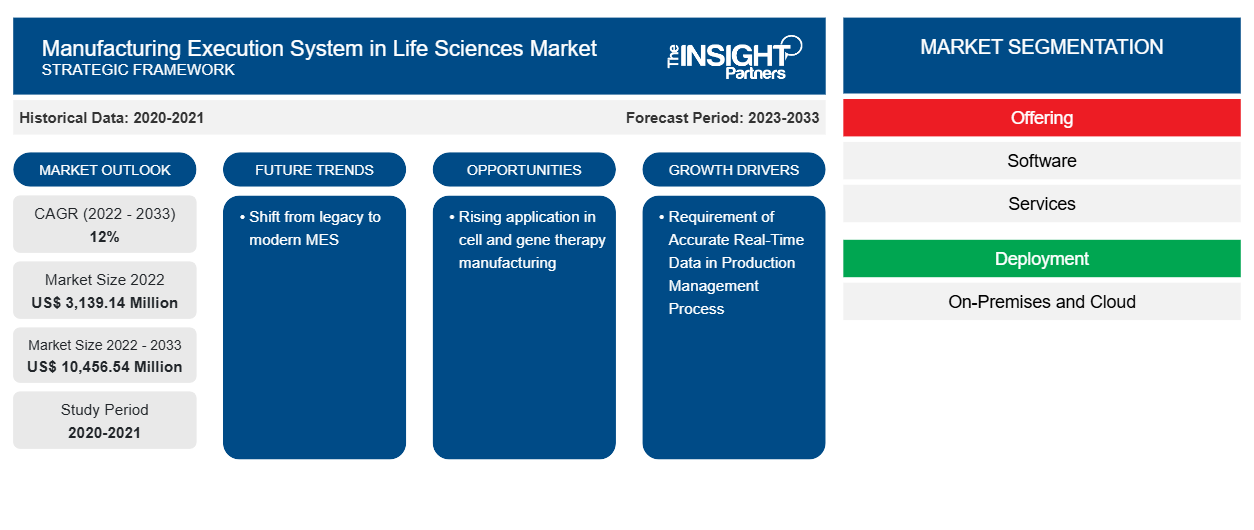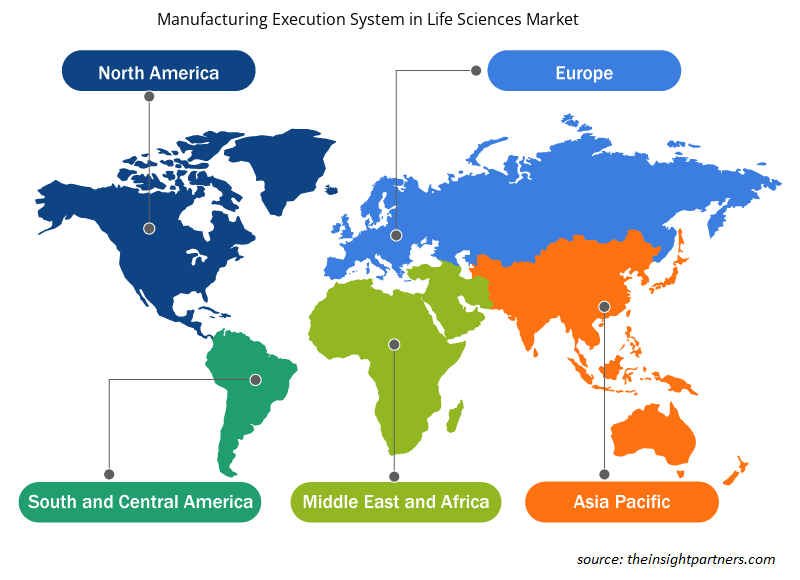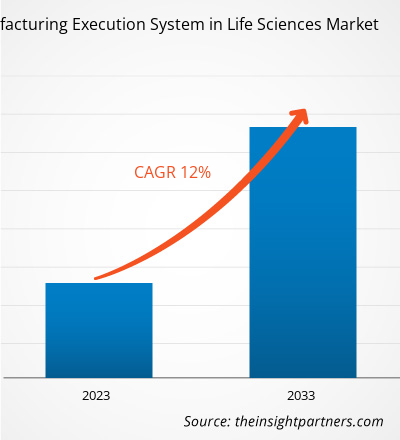Si prevede che la dimensione del mercato del sistema di esecuzione della produzione nelle scienze della vita raggiungerà 10.456,54 milioni di dollari entro il 2033, rispetto ai 3.139,14 milioni di dollari del 2022. Si prevede che il mercato registrerà un CAGR del 12% nel periodo 2023-2033. È probabile che il passaggio dal MES legacy al MES moderno rimanga una tendenza chiave nel mercato.
Analisi di mercato del sistema di esecuzione della produzione nelle scienze della vita
Le moderne soluzioni MES stanno abbracciando più aspetti delle piattaforme di pianificazione delle risorse aziendali (ERP). Ciò consente loro di offrire un migliore monitoraggio della logistica, identità dei materiali e integrazione con le operazioni di produzione, insieme a un modello distribuito che supera la produzione tradizionale. Inoltre, le tradizionali soluzioni MES sono focalizzate sulla produzione in lotti e sono spesso incapaci di offrire le capacità necessarie senza una personalizzazione significativa. Nel periodo di previsione, si prevede che tali fattori promuoveranno l'adozione di moderni sistemi di esecuzione della produzione tra i ricercatori di scienze biologiche.
Panoramica del mercato del sistema di esecuzione della produzione nelle scienze della vita
Il manufacturing execution system (MES) è una soluzione dinamica e completa che aiuta a tracciare, documentare, monitorare e controllare il processo di produzione di beni, dalle materie prime ai prodotti finiti. Queste soluzioni forniscono inoltre ai decisori dati multivariati che possono essere utilizzati per ottimizzare le operazioni di stabilimento e migliorare l'efficienza produttiva. Il MES può avere funzionalità estese, in genere denominate funzioni di manufacturing operations management (MOM). Il termine "manufacturing operations management" è definito come Livello 3 dello standard ANSI/ISA-95 Enterprise-Control System Integration.
Personalizza questo report in base alle tue esigenze
Riceverai la personalizzazione gratuita di qualsiasi report, comprese parti di questo report, o analisi a livello nazionale, pacchetto dati Excel, oltre a usufruire di grandi offerte e sconti per start-up e università
Sistema di esecuzione della produzione nel mercato delle scienze della vita: approfondimenti strategici

-
Scopri le principali tendenze di mercato in questo rapporto.Questo campione GRATUITO includerà analisi di dati che spaziano dalle tendenze di mercato alle stime e alle previsioni.
Sistema di esecuzione della produzione nel mercato delle scienze della vita: driver e opportunità
Requisito di dati accurati in tempo reale nel processo di gestione della produzione
MES può aiutare le aziende manifatturiere a lavorare con una forza lavoro ridotta, raccogliere dati accurati in tempo reale dal processo di produzione, aumentare l'efficienza e la flessibilità dei processi, salvaguardare le aspettative normative e digitalizzare il processo di produzione.
Nel febbraio 2022, Intege ha annunciato di aver acquisito il Manufacturing Execution System (MES) di Critical Manufacturing per migliorare l'efficienza e la qualità dei suoi processi di produzione globali. L'azienda utilizzerà questo modulo nel suo sito in Irlanda per digitalizzare i suoi processi di produzione, raccogliere dati in tempo reale e migliorare l'efficienza, la qualità e la tracciabilità. Analogamente, nel settembre 2020, Körber e Walvax Biotechnology hanno annunciato di aver firmato un accordo per implementare Werum PAS-X MES, il MES per la produzione farmaceutica, biotecnologica e di terapia cellulare e genica, nel suo stabilimento di Yuxi per la produzione di vaccini. Secondo Körber, PAS-X MES consente all'utente di gestire, visualizzare e analizzare i dati in modo rapido, completo e in tempo reale. Nell'agosto 2019, Takeda Ireland Ltd. ha implementato PAS-X MES con un approccio graduale nel suo sito di produzione di Grange Castle, in Irlanda, e lo ha trasformato in una fabbrica senza carta. Tale crescente adozione di MES da parte degli operatori di mercato per la raccolta di dati accurati in tempo reale nel processo di gestione della produzione sta stimolando la crescita dei sistemi di esecuzione della produzione nel mercato delle scienze biologiche. Inoltre, le moderne soluzioni MES (spesso denominate MES leggere) sono altamente flessibili, personalizzate in base alle esigenze, integrano vari strumenti e sono basate su cloud . Inoltre, MES e Laboratory Execution Systems (LES) possono anche aiutare a ridurre il rischio di contaminazione, migliorare l'integrità dei dati, abbassare i costi operativi, garantire la conformità normativa e la qualità e migliorare le capacità di tracciamento e rintracciabilità. Grazie a tutti i vantaggi sopra menzionati dell'utilizzo di MES, vari operatori di mercato stanno adottando il sistema.
Crescente applicazione nella produzione di terapia cellulare e genica
C'è anche un numero crescente di collaborazioni tra i principali fornitori di soluzioni dell'ecosistema dell'industria manifatturiera farmaceutica per lo sviluppo di soluzioni avanzate per la produzione di prodotti di terapia cellulare e genica. A gennaio 2022, TrakCe ha collaborato con Korber per l'integrazione del software. La collaborazione ha portato a un'integrazione funzionale tra OCELLOS di TrakCel e PAS-X di Körber. Si prevede che consentirà ai clienti di terapia cellulare e genica di entrambe le aziende di condividere in modo efficace i dati che descrivono in dettaglio eventi e traguardi di produzione come controlli iniziali, riempimento e finitura e rilascio del prodotto; e fornire registri di tracciabilità e audit completi. A ottobre 2021, Körber e Vineti hanno annunciato una partnership per integrare PAS-X MES di Korber con la piattaforma Personalized Therapy Management (PTM) leader del settore di Vineti. Questa partnership fornirà ulteriormente ai clienti biofarmaceutici una soluzione PAS-X MES integrata, che aiuterà a portare terapie cellulari e geniche salvavita ai pazienti bisognosi. Pertanto, si prevede che la crescente applicazione e adozione del MES da parte degli operatori del mercato nella produzione di terapie cellulari e geniche creerà un'opportunità di crescita del sistema di esecuzione della produzione nel mercato delle scienze biologiche durante il periodo di previsione.
Analisi della segmentazione del rapporto di mercato del sistema di esecuzione della produzione nelle scienze della vita
I segmenti chiave che hanno contribuito alla derivazione dell'analisi del mercato del sistema di esecuzione della produzione nelle scienze della vita sono l'offerta, l'implementazione, le dimensioni dell'organizzazione e l'applicazione.
- In base all'offerta, il sistema di esecuzione della produzione nel mercato delle scienze biologiche è suddiviso in hardware e software. Il segmento software ha detenuto una quota di mercato maggiore nel 2023.
- In base all'implementazione, il mercato è segmentato in on-premise e cloud.
- In base alle dimensioni dell'organizzazione, il mercato è segmentato in PMI e grandi imprese.SMEs and large enterprises.
- In base all'applicazione, il mercato è segmentato in farmaceutico, biotecnologico e dei dispositivi medici.
Analisi della quota di mercato del sistema di esecuzione della produzione nelle scienze della vita per area geografica
L'ambito geografico del rapporto sul mercato del sistema di esecuzione della produzione nelle scienze della vita è principalmente suddiviso in cinque regioni: Nord America, Asia Pacifico, Europa, Medio Oriente e Africa e Sud e Centro America. In Nord America, si prevede che le innovazioni tecnologiche offrano opportunità di crescita per il sistema di esecuzione della produzione nel mercato delle scienze della vita. Inoltre, la crescente digitalizzazione dei processi di produzione nell'industria farmaceutica sta alimentando la crescita del sistema di esecuzione della produzione nel mercato delle scienze della vita nella regione. Inoltre, la presenza di attori del mercato come Apprentice FS, Inc; Atachi Systems; Emerson Electric Co; POMS Corporation; e Rockwell Automation, che lavorano costantemente per semplificare i processi di produzione nel settore sanitario, sta stimolando la crescita del sistema di esecuzione della produzione nel mercato delle scienze della vita.
Sistema di esecuzione della produzione nel mercato delle scienze della vita: approfondimenti regionali
Le tendenze regionali e i fattori che influenzano il Manufacturing Execution System in Life Sciences Market durante il periodo di previsione sono stati ampiamente spiegati dagli analisti di Insight Partners. Questa sezione discute anche i segmenti e la geografia del Manufacturing Execution System in Life Sciences Market in Nord America, Europa, Asia Pacifico, Medio Oriente e Africa e Sud e Centro America.

- Ottieni i dati specifici regionali per il sistema di esecuzione della produzione nel mercato delle scienze della vita
Ambito del rapporto di mercato sul sistema di esecuzione della produzione nelle scienze della vita
| Attributo del report | Dettagli |
|---|---|
| Dimensioni del mercato nel 2022 | 3.139,14 milioni di dollari USA |
| Dimensioni del mercato entro il 2033 | 10.456,54 milioni di dollari USA |
| CAGR globale (2022 - 2033) | 12% |
| Dati storici | 2020-2021 |
| Periodo di previsione | 2023-2033 |
| Segmenti coperti |
Offrendo
|
| Regioni e Paesi coperti |
America del Nord
|
| Leader di mercato e profili aziendali chiave |
|
Sistema di esecuzione della produzione nel mercato delle scienze della vita Densità degli attori: comprendere il suo impatto sulle dinamiche aziendali
Il mercato del Manufacturing Execution System in Life Sciences Market sta crescendo rapidamente, spinto dalla crescente domanda degli utenti finali dovuta a fattori quali l'evoluzione delle preferenze dei consumatori, i progressi tecnologici e una maggiore consapevolezza dei vantaggi del prodotto. Con l'aumento della domanda, le aziende stanno ampliando le loro offerte, innovando per soddisfare le esigenze dei consumatori e capitalizzando sulle tendenze emergenti, il che alimenta ulteriormente la crescita del mercato.
La densità degli operatori di mercato si riferisce alla distribuzione di aziende o società che operano in un particolare mercato o settore. Indica quanti concorrenti (operatori di mercato) sono presenti in un dato spazio di mercato in relazione alle sue dimensioni o al valore di mercato totale.
Le principali aziende che operano nel mercato dei sistemi di esecuzione della produzione nelle scienze della vita sono:
- Siemens AG
- Emerson elettrico
- Schneider elettrico
- Automazione Rockwell
- Apprendista FS Inc
- ATS globale
Disclaimer : le aziende elencate sopra non sono classificate secondo un ordine particolare.

- Ottieni la panoramica dei principali attori del mercato del sistema di esecuzione della produzione nelle scienze della vita
Sistema di esecuzione della produzione nel mercato delle scienze della vita: notizie e sviluppi recenti
Il sistema di esecuzione della produzione nel mercato delle scienze della vita viene valutato raccogliendo dati qualitativi e quantitativi dopo la ricerca primaria e secondaria, che include importanti pubblicazioni aziendali, dati associativi e database. Di seguito sono elencati alcuni degli sviluppi nel sistema di esecuzione della produzione nel mercato delle scienze della vita:
- Lonza e NNIT hanno annunciato una partnership per accelerare i progetti MES. Le aziende collaboreranno sulla piattaforma MODA di Lonza con la metodologia di implementazione accelerata di NNIT. (Fonte: Lonza, comunicato stampa, marzo 2021.)
- AVEVA, leader mondiale nel software industriale, che guida la trasformazione digitale e la sostenibilità, ha ampliato CONNECT, la sua piattaforma di intelligence industriale leader a livello mondiale, con servizi di dati e visualizzazione per soluzioni ibride Manufacturing Execution System (MES). (Fonte: AVEVA, comunicato stampa, aprile 2023)
Copertura e risultati del rapporto di mercato sul sistema di esecuzione della produzione nelle scienze della vita
Il rapporto "Dimensioni e previsioni del mercato del sistema di esecuzione della produzione nelle scienze della vita (2023-2033)" fornisce un'analisi dettagliata del mercato che copre le seguenti aree:
- Sistema di esecuzione della produzione nel mercato delle scienze della vita, dimensioni e previsioni a livello globale, regionale e nazionale per tutti i segmenti di mercato chiave coperti dall'ambito
- Sistema di esecuzione della produzione nelle tendenze del mercato delle scienze della vita e dinamiche di mercato come driver, vincoli e opportunità chiave
- Analisi dettagliata delle cinque forze PEST/Porter e SWOT
- analisi del mercato del sistema di esecuzione della produzione nelle scienze della vita che copre le principali tendenze del mercato, il quadro globale e regionale, i principali attori, le normative e i recenti sviluppi del mercato
- Analisi del panorama industriale e della concorrenza che copre la concentrazione del mercato, l'analisi della mappa di calore, i principali attori e gli sviluppi recenti per il sistema di esecuzione della produzione nel mercato delle scienze della vita
- Profili aziendali dettagliati
- Analisi storica (2 anni), anno base, previsione (7 anni) con CAGR
- Analisi PEST e SWOT
- Valore/volume delle dimensioni del mercato - Globale, Regionale, Nazionale
- Industria e panorama competitivo
- Set di dati Excel
Report recenti
Testimonianze
Motivo dell'acquisto
- Processo decisionale informato
- Comprensione delle dinamiche di mercato
- Analisi competitiva
- Analisi dei clienti
- Previsioni di mercato
- Mitigazione del rischio
- Pianificazione strategica
- Giustificazione degli investimenti
- Identificazione dei mercati emergenti
- Miglioramento delle strategie di marketing
- Aumento dell'efficienza operativa
- Allineamento alle tendenze normative






















 Ottieni un campione gratuito per - Sistema di esecuzione della produzione nel mercato delle scienze della vita
Ottieni un campione gratuito per - Sistema di esecuzione della produzione nel mercato delle scienze della vita